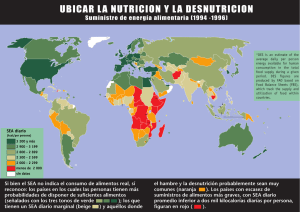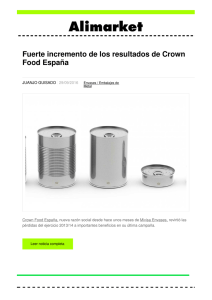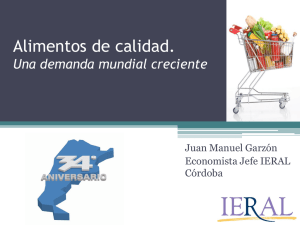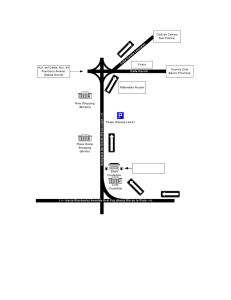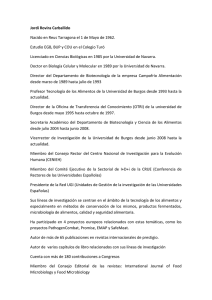90 CAPITULO IX BIBLIOGRAFÍA ALZAMORA, S.M., Cerrutti P
Anuncio
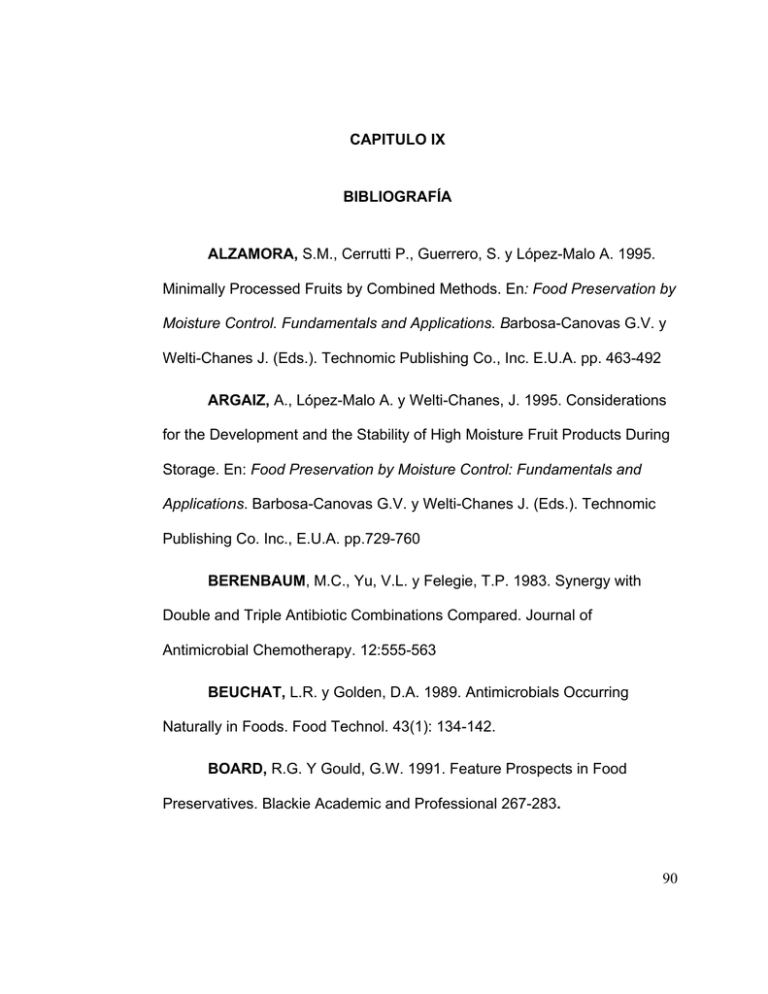
CAPITULO IX BIBLIOGRAFÍA ALZAMORA, S.M., Cerrutti P., Guerrero, S. y López-Malo A. 1995. Minimally Processed Fruits by Combined Methods. En: Food Preservation by Moisture Control. Fundamentals and Applications. Barbosa-Canovas G.V. y Welti-Chanes J. (Eds.). Technomic Publishing Co., Inc. E.U.A. pp. 463-492 ARGAIZ, A., López-Malo A. y Welti-Chanes, J. 1995. Considerations for the Development and the Stability of High Moisture Fruit Products During Storage. En: Food Preservation by Moisture Control: Fundamentals and Applications. Barbosa-Canovas G.V. y Welti-Chanes J. (Eds.). Technomic Publishing Co. Inc., E.U.A. pp.729-760 BERENBAUM, M.C., Yu, V.L. y Felegie, T.P. 1983. Synergy with Double and Triple Antibiotic Combinations Compared. Journal of Antimicrobial Chemotherapy. 12:555-563 BEUCHAT, L.R. y Golden, D.A. 1989. Antimicrobials Occurring Naturally in Foods. Food Technol. 43(1): 134-142. BOARD, R.G. Y Gould, G.W. 1991. Feature Prospects in Food Preservatives. Blackie Academic and Professional 267-283. 90 BRANEN, A.L. 1993. Introduction to Use of Antimicrobials. Cap 1. En: Antimicrobials in Foods. 2da. Ed. PM. Davidson y AL. Branen (Eds.),. Marcel Dekker, Inc., New York. pp.1-9 BROCK, T.D. y Madigan, y MT. 1991. Microbiología. Sexta ed. Prentice Hall Hispanoamericana, S. A. México BULLERMAN, LB., Tsai, W y Hlywka, K. 1994 Mold content of commercial popcorn. J. Food Prot. 58:1014-1017. CONNER, DE., y Beuchat, LR. 1984. Effects of Essential Oils from Plants on Growth of Food Spoilage Yeasts. Journal of Food Science, 49:429434 DAVIDSON, PM. 1996. Chemical Preservatives and Natural Antimicrobial Compounds. En: Doyle MP, Beuchat LR, Montville TJ, eds. 1997. Food Microbiology- Fundamentals and Frontiers. Washington DC: ASM Press:530-556 DAVIDSON, PM. y Parish, ME. 1989. Methods for Testing the Efficacy of Food Antimicrobials. Food Technology, 43(1):148-155 DAVIDSON, PM. y Branen, AL. (EDS) 1993, Antimicrobials in Foods. Marcel Dekker Inc., New York DECAGON DEVICES, 2001. AquaLab water activity. Pullman Washington, USA. Http://decagon.com/aqualab/hurdle.html 91 EKLUND, T. 1989. Organic Acids and Esters. En: Mechanisms of Action of Food Preservation Procedures. G.W. Gould (Ed.). Elsevier Applied Science, London. Pp. 161-200 ELIOPOULOS, GM. y Moellering, RC. . 1991. Antimicrobial Combinations. En Antibiotics in Laboratory Medicine. V. Lorian (ed). 3a Ed. Williams y Wilkins. E.U.A. pp.432-492 FRAZIER, WC. y Westhoff, DD. 1978. Microbiología de los Alimentos. Acribia, S. A. España. GACULA, M. C. y Singh, J. 1984. Statistical methods in Food and Costumers Research. Academic Press. Orlando Fl. GOULD, GW., Brown, MH., y Fletcher, BC: 1983. Mechanisms of Action of Food preservation procedures. En : Food Microbiology advances and Prospects. Roberts, TA y Skiner FA. Academic Press, New York. pp1-10 GOULD, GW. 1995. Homeostatic Mechanisms During Food Preservation by Combined Methods. En: Food Microbiology, Advances and Prospects. Ed. Roberts, T.A., y Skinner, F.A. Academic Press, N.Y. GOULD, GW. 1996. Industry Perspectives on the Use of Natural Antimicrobials and Inhibitors for Food Applications. Journal of Food Protection. Supplement 82-86. 92 GOULD, G. W. y Russell, N. J. 1991. Major Food-Poisoning and Food Spoilage Microorganisms. En: Russel, NJ y Gould GW (Eds): Food Preservatives. Blackie &Son Ldt. Glasgow. pp. 1-12. Citado en : López-Malo, A. 2000. La Preservación multiobjeto de Alimentos.: Efecto de Factores Tradicionales y Emergentes en la Respuesta de Aspergillus flavus. Tesis doctoral. Universidad de Buenos Aires. ICMSF (International Commission on Microbiological Specifications for Foods). 1996. Microorganisms in Foods 5; Microbial Specifications of Food Pathogens. Blackie Academic & Professional. Reino Unido IDZIAK, ES. 2002. Student guide to Food Microbiology and Sanitation. McGill, Canadá. ISMAIEL, A. Y Pierson, MD. 1990. Inhibition of Growth and Germination of C. botulinum 33 A, 40 B y 1623 E by essential oil of spices. J. Food Sci. 55(6):1676. JAY, J. 1992. Modern Food Microbiology. 4ta. Ed. Van Nostrand Reinhold, New York. JUVEN, BJ., Kanner, J., Schved, F. y Weisslowicz, H. 1994. Factors that Interact with the Antibacterial Action of Thyme Essential Oil and its Active Constituents. J. Appl. Bacteriol. 76:626-631. Citado en: Lopez Malo, A. 2000. La Preservación Multiobjetivo de Alimentos: Efecto de Factores 93 Tradicionales y Emergentes en la Respuesta de Aspergillus flavus. Tesis doctoral. Universidad de Buenos Aires. KABARA, JJ. 1993. Medium-Chain Fatty Acids Esters. En: Antimicrobials in Foods. PM Davidson & Al Branen. Marcel Dekker, Inc. New York. KATAYAMA, T. y Nagai, I. 1960. Chemical Significance of the Volatile Components of Spices from the Food Preservation Standpoint. IV. Structure and Bacterial Activity of Some Terpenes. Nippon Suisan Gakkaishi 26:29 LEISTNER, L. 1995. Principles and Applications of Hurdle Technology. En: New Methodos of Food Preservation. G.W. Gould. (Ed.). Blakie Academics & Professional. Glasgow. P.1-21. Citado en: Lopez Malo, A. 2000. La Preservación Multiobjetivo de Alimentos: Efecto de Factores Tradicionales y Emergentes en la Respuesta de Aspergillus flavus. Tesis doctoral. Universidad de Buenos Aires. LEÓN, R. 2002 Espectro de Acción de Mezclas Ternarias de Agentes Antimicrobianos. Tesis de Maestría. Universidad De Las Américas-Puebla. LÓPEZ-MALO, A. 2000. La Presentación Multiobjetivo de Alimentos: Efecto de Factores Tradicionales y Emergentes en la Respuesta de Aspergillus flavus. Tesis Doctoral. Universidad de Buenos Aires. 94 LÓPEZ-MALO, A. Alzamora, SM. y Argaiz, A. 1995. Effect of Natural Vanillin on Germination Time and Radial Growth of Moulds in Fruit-Based Agar Systems. Food Microbiology, 12:213-219 LÓPEZ-MALO, A. Alzamora, SM. y Argaiz, A. 1998. Vanillin and pH Synergystic Effects on Mould Grouth. Journal of Food Science, 63:143-146 MATAMOROS-LEON, B., Argaiz, a y López-Malo a. 1999 Individual and Combined Effects of Vanillin and Potasium Sorbate on Pencicllium digitatum, Pencicllium glabrum, and Pencicllium italicum Growth. J. Food Prot. 62 (5):540-542 NYCHAS, GJ.E. 1995. Natural Antimicrobials from Plants. En: New methods of Food Preservation. G.W. Gould (Ed.). Blakie Academic & Professional. Glasgow. P. 1-21. Citado en: Welti-Chanes, J., VergaraBalderas, F., y Lopez Malo, A. 1997. Minimally Processed foods State of the art and future. En: P. Fito, E. Ortega- Rodriguez y G. Barbosa-Canovas (eds). Food engineering 2000. E.U.A. Chapman & Hall. P. 181-212. SANTIESTEBAN, A. 2002. Agentes Antimicrobianos de Alto Espectro a Partir de Mezclas de Agentes Antimicrobianos Sintéticos Naturales. Tesis de Maestría. Universidad de las Américas-Puebla SOFOS, JN., Beuchat, LR., Davidson, PM. y Johnson, EA. 1998. Naturally Ocurring Antimicrobials in food. Council for Agricultural Science and Technology (CAST). Ames, IA. 95 WELTI-CHANES, J. 1995. Investigación en Ciencia y Tecnología de Alimentos: Estado Actual y Desarrollo Futuro en la Conservación y Procesamiento de Alimentos. Cuadernos de Nutrición, 21(4):21-28 WELTI-CHANES, J. Vergara, F. Y López-Malo, A. 1997. Minimally Processed Foods, State of the Art and Future. En: Food Engineering 2000. Fito, P., Ortega, E. y Barbosa, G. (Eds). Chapman ZAIKA, L.1988 Spices and herbs: Their Antimicrobial Activity and it’s Determination. J. Food Safetyu. ),97-1 18 96
